All You Need to Know About the Lascaux Cave
Located in southern France, the Lascaux Cave houses some of the most famous prehistoric cave paintings, dating to approximately 15,000 BCE. The cave...
Vithória Konzen Dill 12 September 2024
Stonehenge is one of the most famous archeological sites in the world, located in the county of Wiltshire, UK. Nowadays we do know some things about it, but a large number of legends, hypotheses, and myths still remain. Uncertainty about the origins and purposes of Stonehenge is now a key point of its identity. Let’s discover facts and theories about Stonehenge!
Stonehenge is an archeological site likely to have appeared during the Neolithic period. It is situated near Amesbury, in Wiltshire, UK, and was designated as a UNESCO World Heritage Site in 1986.
The site is a circular collection of huge vertical rectangular rocks, known as megaliths, which sometimes carry a horizontal rock on top, working as an architrave and making them the famous trilithons. The modern name recalls the basic construction of the site: “henge” derives from “hang”, so “hanging rocks”.
On the other hand, in the ancient language of the region, it was simply called “cromlech”, or a circle of rocks.
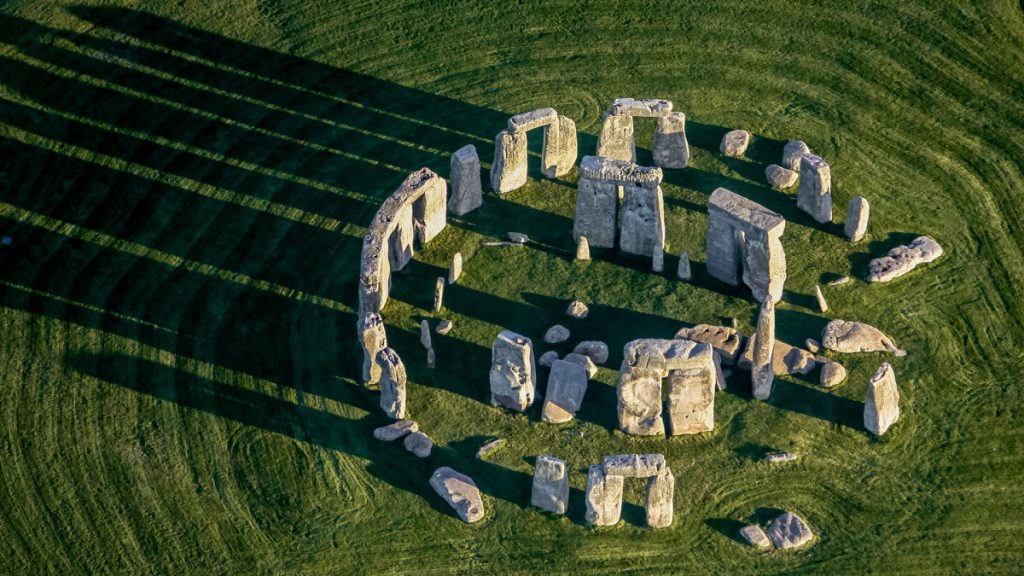
View of the inner circle of Stonehenge, ca 3500-1500 BCE, Wiltshire, UK. Photo by David Goddard/Getty Images via History.com.
Globally, historians believe that Stonehenge is the result of different episodes of construction, destruction, and decay. The last was during the 1900s, so quite recently.
At that time, many stones were re-erected or straightened in order to restore the site’s original beauty. Therefore, the current alignment of the rocks reflects this latest reconstruction. However, a certain number of stones are still missing, some holes are empty, and some geometrical proportions are not respected. For this reason, unfortunately, the original map of the site is not completely clear.
The first trace of the site was probably a circular canal, with an inner bank and a smaller outer bank, built about 3000 BCE. It is called the “earthwork enclosure” on the map. There were probably two original entrances, one to the northeast side and a secondary one on the southern side. Inside the bank, there are 56 pits, also known as the Aubrey Holes. In the 1920s, the walls of these holes were reinforced with concrete.
And now we come to the core, the heart of Stonehenge or the central cluster. These stones date back to about 2500 BCE and have two varieties. There are the sarsens, larger and arranged in two concentric forms, and the bluestones, from the typical bluish color when wet. The outer sarsen circle is capped with lintels and among them some bluestones.
Meanwhile, the inner concentric arrangement has a U-shape and is composed of five trilithons, three of which are still complete. In the center, there is the Altar Stone, partly covered by a fallen stone.
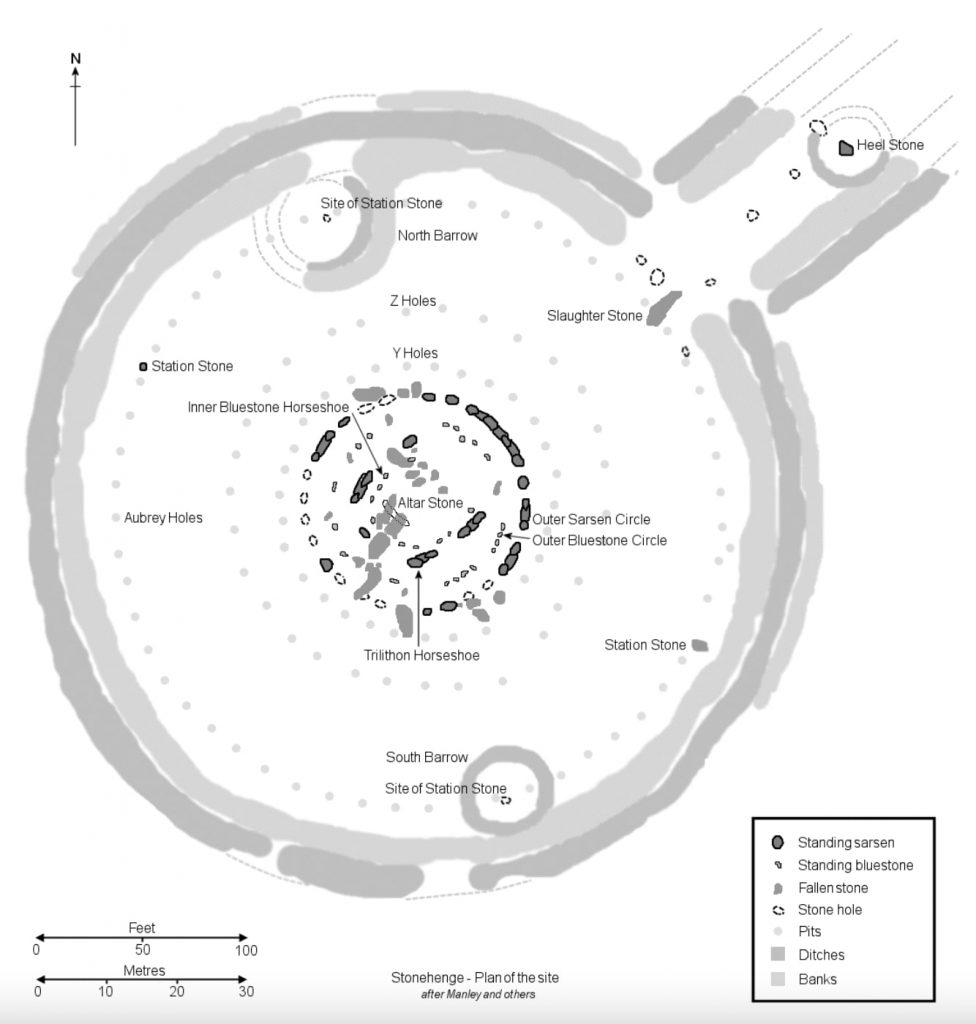
Schematic representation of the site as seen from above. Stone-circles.org.uk.
Around the central part of Stonehenge, we can find other geometries. A rectangle probably surrounded the construction, as hypothesized by looking at the two Station stones still standing and likely representing two of the corners.
Moreover, outside the northeast entrance lies the Heel Stone, a particular unshaped sarsen piece whose origin is not clear. It may have been an early stone at the site. Not far away is the Slaughter Stone, a fallen sarsen that may have served as a sort of gate.
Finally, at the entrance of the earthwork enclosure, the Avenue begins. This is a pathway probably used to connect the cromlech with the river Avon.
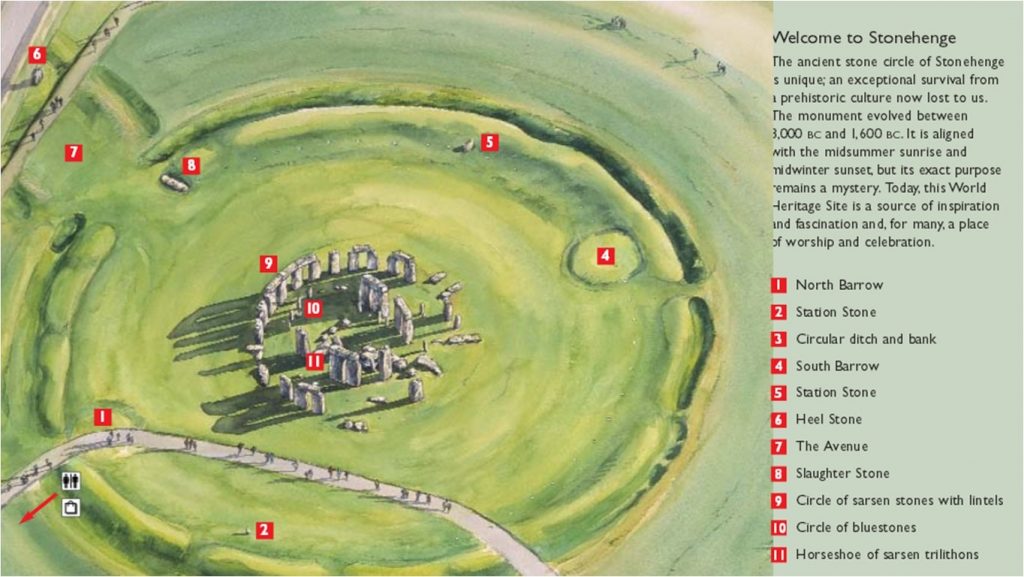
Map of the site of Stonehenge in 3D. Pinterest.
The main axis of the stones is aligned with the solstitial axis. On June 21st, the sun rises over the horizon to the northeast, near the Heel Stone. On December 22nd, the sun sets in the southwest, between the two tallest trilithons. This seasonal alignment is proven and reproducible, therefore it should have been significant for the people who built Stonehenge.
As a result, today, besides mass tourism, Stonehenge is a popular place of pilgrimage for followers of the Celtic religion, Wicca, and other neo-pagan religions. Some of these visitors wish to recreate the magical atmosphere of those days, and at Stonehenge, this is not so difficult!
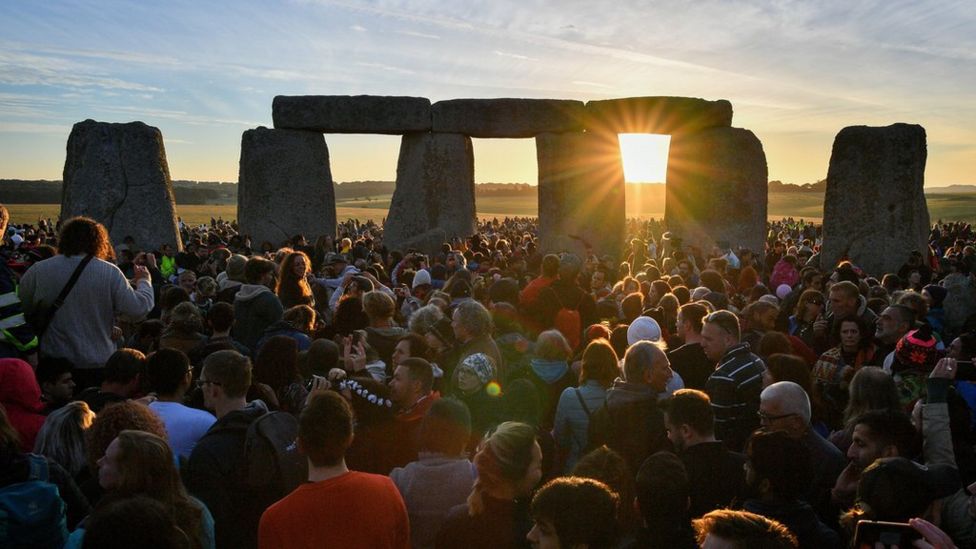
People waiting for the sunrise on June 21st, or summer solstice. BBC.
Stonehenge is one of the earliest examples of excellent engineering when technology was still rudimentary. For this reason, it surely required lots of resources, people, and planning.
The first construction was the earthwork enclosure (3000 BCE), with a ring of 56 timbers within. The scope of this was probably a cremation cemetery. In the following centuries, more stones were added in the middle, the remnants of which are the stones we see today.
Here there are two types of rocks, as previously mentioned. The first are sarsen stones, a type of silcrete rock generally found in southern England. Archeologists have always hypothesized that they came from Marlborough Downs, about 32 km away from the site. Thanks to further investigation, the origin of these stones was recently not only confirmed but also better identified. It is a small area called West Woods, in a region southwest of Marlborough. They weigh about 25 tons each.
The second are bluestones, smaller rocks that very probably were brought from the Preseli Hills (southwest Wales). They are called after the blue color they show when broken or wet and weigh an average of 3.5 tons.
Researchers think bluestones could be part of another stone circle outside Stonehenge, probably in Preseli Hills itself, where holes compatible with the previous presence of stones have been recently found. When brought to Stonehenge, they were maybe in the so-called Q and R holes, before being moved to the actual position. Whatever the origin, it is still not completely clear how the transport was possible.
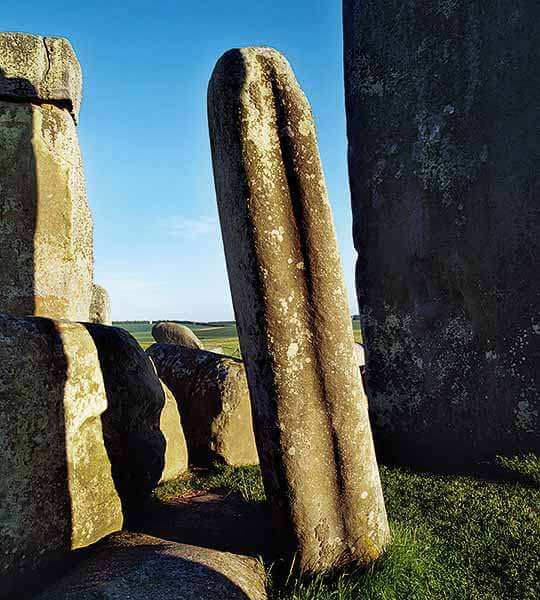
One of the bluestones at Stonehenge, with a line shaped to fit together with other stones. English Heritage.
The rocks were probably shaped in the field next to Stonehenge where waste materials and tools have been found. For unknown reasons, some stones were more finished than others.
Then, after transport and shaping, it was time to erect the stones. The builders likely dug a hole with a sloping side and a number of wooden cylinders. After positioning the rock in this hole, it was erected probably using ropes. Finally, the hole was filled in again. Meanwhile, to raise the horizontal lintels, sources suggest timber platforms could have been used.
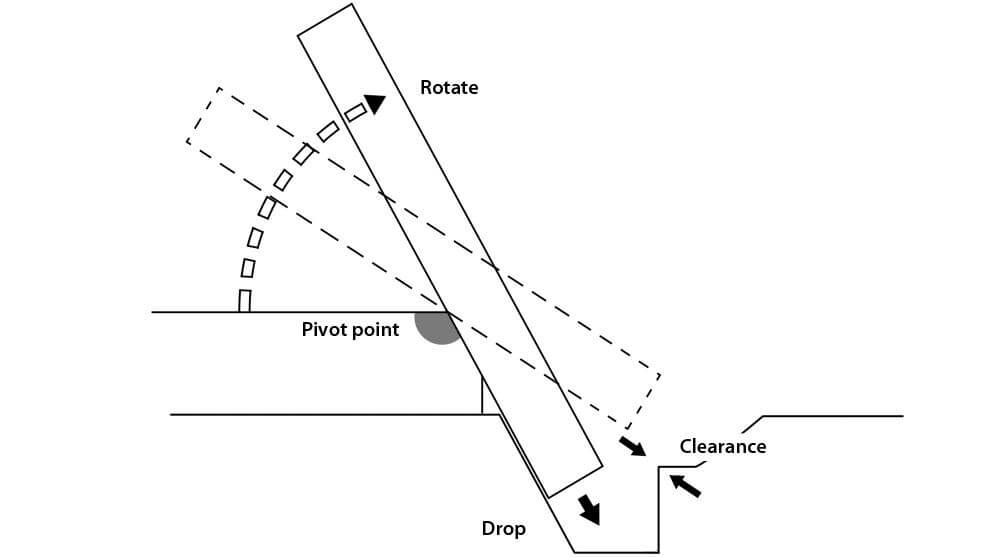
Schematic representation of a stone rotated on a pivot and dropped into holding pit. Creation.com.
Historians and archeologists have speculated on the purpose of the site for centuries. Considering the actual settlement as a faithful reproduction of the original one and considering the orientation of the stones, many think that Stonehenge was a sort of calendar, an ancient astronomic observatory. Every year a Summer Solstice celebration still takes place here to remember this supposed aim.
In the Victorian Era, some people thought Stonehenge was a Druid temple, a central point in the lives of the Celtic population. Although today Stonehenge is proven to be more ancient than the Celtic period, it is still a symbolic destination for new-age druidic societies.
Recently the discovery of a large amount of human bones changed the probabilities. This gave credit to the theory that Stonehenge was an ancient cemetery with a ceremonial complex within. Following other research, the burial ground could predate the monumental complex, thus making Stonehenge a temple for the remembrance of death and dead people built in the following centuries.
Other weird theories were proposed. An essay spoke in favor of a “vulva hypothesis”, explaining the shape of the monument as “the opening by which Earth Mother gave birth to the plants and animals on which the ancient people so depended”.
Some other people called aliens into question because of the believed difficulty of raising such a structure with only human tools and technologies. According to them, extraterrestrials built Stonehenge which is a landing pad for spacecrafts.
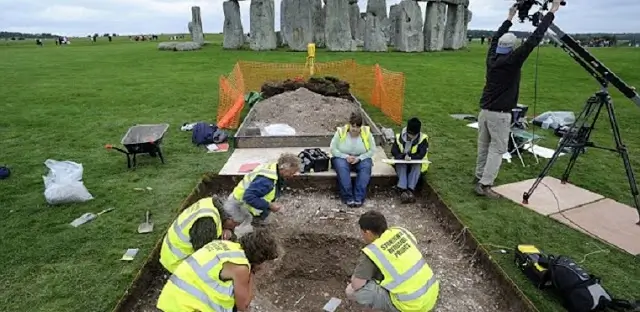
Researchers finding bones at Stonehenge site, 2016. Percevalasnotizie.
Of course, such a magic place also gave credit to many legends:
The first well-known one is about Merlin, the famous wizard. In the 5th century a battle took place between British noblemen versus Saxons. According to the legend, these noblemen were buried at the actual location of Stonehenge. Their king wished to build a monument to honor them, possibly with magical rocks coming from Africa which had been moved to Ireland by giants. Therefore, the king sent an army, with Merlin as a commander, to bring the stones to England. In the end, they defeated the Irish army, which was protecting the rocks, but could not move them, so Merlin the wizard finally did it (of course through his magical power).
Another story involves the Devil as the constructor of Stonehenge. He wanted to use some stones owned by an elderly Irish woman. So he disguised himself as a common man and made an offer to her. In exchange for the rocks, he agreed to pay her as many gold coins as she could count before he finished the placement of the rocks. She thought it could be a fair challenge, so she agreed. However, the Devil instantly moved the stones, thanks to his supernatural power, and did not pay the woman.
Upon arriving in England, the Devil said that he was sure nobody could guess the number of rocks of Stonehenge. A clever friar guessed correctly and the Devil threw a stone at him, hitting the friar on the heel. Thus the origin of the Heel Stone.
According to another legend, once upon a time, some giants lived on the field of Stonehenge. They were dancing when suddenly they turned into pieces of rock.
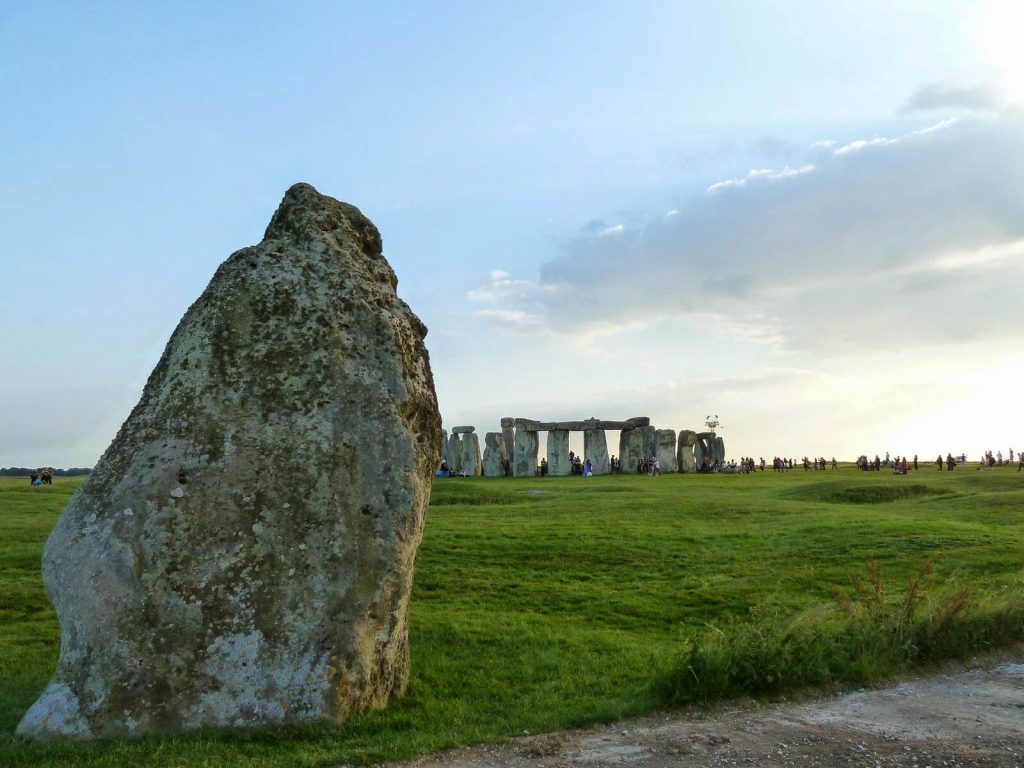
The Heel Stone, a sarsen. About 3000–1500 BCE. Stones of Stonhenges.
DailyArt Magazine needs your support. Every contribution, however big or small, is very valuable for our future. Thanks to it, we will be able to sustain and grow the Magazine. Thank you for your help!